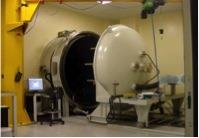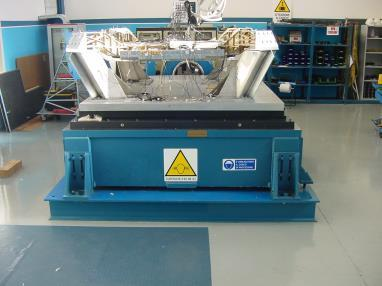AHEAD 2015-2019
Web pages: SERMS , CEM Laboratory
Description of the infrastructure
The Space Test Laboratories of the Perugia University are located in the Polo Scientifico Didattico di Terni. Two close installations, the SERMS and the CEM laboratories, provide coordinated services and qualification tests according to the required standards for instrumentation to be operated in space and/or hostile environment. All the instrumentation in the infrastructure is calibrated on a yearly basis by a certified procedure performed in agreement with the standard ISO 9001:2008. The infrastructure is operative for 220 working days per year.
Careful design and a detailed thermal and mechanical stress analysis of a device are among the key points to reach its full reliability. Extensive experimental campaigns are also usually applied to test the system functionality in the expected environmental conditions and to verify the mechanical/thermal behavior of the instrument and its electromagnetic interference with the surrounding equipment. In the Space Test Laboratories, mechanical/thermal and electronics design capabilities and the infrastructure for mechanical/thermal/vacuum/electromagnetic testing of payloads are integrated to provide a complete assistance in the field.
In the last two decades, collaboration with international research projects and industrial partners have been carried out continuatively in this infrastructure giving the opportunity to train highly qualified personnel, motivated in finding custom solutions to peculiar problems. The Fermi-LAT gamma-ray observatory and the AMS-02 cosmic ray telescope, successfully operating in orbit since 2008 and 2011 respectively, are the main scientific instruments which have been developed with the support of this infrastructure as in kind contribution to the international scientific collaborations. Qualification tests of the ASTRO-H SXS-filter wheel and POLAR electronics, due to be launched in 2015, have been also performed in the Space Test Labs as an external facility. Infrastructure is also open to external access for scientific payloads and industrial applications with a detailed service pricelist. For the H2020 program we plan to offer the access to installations and the required assistance just on the basis of the overall running costs of the installations, which accounts for ≈30-50% of the standard pricelist cost for most of the offered services.
Installation 1 SERMS – The SERMS laboratory was established in 1995 by the university of Perugia and the Istituto Nazionale di Fisica Nucleare (INFN) to provide engineering support to the design and test of the FERMI-LAT and AMS-02 scientific payloads developed in the astro-particle research teams of the University of Perugia and INFN. The close contacts of this facility with major international industrial and research institutions during the AMS qualification process allowed a professional training of the personnel both in design and experimental testing with an objective driven / performance-based approach. An academic spinoff, the SERMS s.r.l., was established in 2003 and, as of today, the laboratory not only provides support to scientific research programs in space, but has extended its activities towards industry with design and qualification test for different applications. The National Institute of Nuclear Physics (INFN) and the SERMS s.r.l., contribute as third parties to the infrastructure, providing part of the personnel, the equipment and a contribution to the running costs of the SERMS laboratory.
On a surface of ≈500m2, facilities for thermal, thermo-vacuum, pressure, salt and fog, drop and impact, vibrational and pyroshock tests are available to assess the behavior and resistance of devices to be used in hostile environments/space.
The main facilities of the SERMS laboratory are:
- Clean rooms: one 4.9×9.30 M5.5 (class 10000) and one 4.99×9.30 m2 M6.5 (class 10000) clean rooms with ambient temperature (T=21+/- 2°C) and humidity (50+/- 10%) control
- Climatic test chambers:
- Angelantoni Mod. CH500C-15ESS , Test Volume 0,85×0,572×0,892 m3, Temperature range: –70°C / +180°C, Heating – Cooling Speed: max 15 °C/min, Humidity Range: 10% / 98% U.R.
- Angelantoni – Mod.EOS 1000 C, Test Volume 1x1x1 m3, Temperature range: –70°C /+180°C, Heating Speed: max 2 °C/min, Cooling Speed: max 1,5 °C/min, Humidity Range: 10% – 98% U.R.
- TY2000WC , Test Volume : 2x1x1 m3, Temperature range: –70°C / +180°C, Heating Speed: max 2 °C/min, Cooling Speed: max 1,5 °C/min
- Thermo-vacuum chamber: Angelantoni Mod. HVT 2000 S/N 10107, Test Volume: cylindrical with 2m inner diameter x 2.1 m length, Temperature Range: 70°C/+125°C, Temperature Gradient: 1°C/min, Vacuum Level: 1 x 10-5 mbar, Coolant fluid: Baysilone. The internal walls of the chamber are coated with a black paint to reproduce the black body optical properties (shroud) and Plates made of aluminium alloy are used for conductive coupling of the test item to the chamber (cold plates). Independent temperature control for shroud and cold plates is available to reproduce different environmental conditions. ISO K (n.3) flanges and DN35CF (n.4) flanges are available with different feed-throughs (DB9, DB15, DB37, LEMO, HV pins) to operate devices under test.
- Pressure simulator: ECOVIDE Mod. VP600. Test Volume: cylindrical with 1.55 m inner diameter x 2.2 m length, max Altitude pressure: 4mBar; max Overpressure 1700 mBar; N° 3 DN200 ISO K flanges available for electrical connections, Fully compliant for Altitude, Overpressure tests according to: RTCA DE160E
- Vibration test systems: two independent shakers are installed in order to operate either independently or in conjunction to perform mechanical vibration in the 5-3000 Hz frequency range according to sine, noise and shock profiles in the horizontal or vertical directions for devices up to 1.6 Ton at the nominal force. Two slip tables (1×1 m^2, 2.1×2.1 m^2) can be connected to the vibration systems to hold large/heavy devices in the test.
- TIRA GmbH S 59349/AIT – 440, A 2 11 3 090 Power Amplifier: Nominal force SINE/NOISE 49.5 kN, SHOCK 148.5 kN for a Max device weight of 910 kg.
Ling Electronics – PN.C335 – SN.2016, Amplifier – Ling Electronics – PN.1212E, C335 Vibration Exciter-mod.2016: nominal force SINE 87.5 kN, NOISE 71kN, SHOCK 14. kN for a Max device weight of 700 kg. - Control/DAQ system: Spectral Dynamics Jaguar SD 2560 , 99 acquisition channels; Workstation: Sun Ultra 10, Software: Sine, Random JAGUAR 2570 ACP 99 channel-1 output system, Drive frequency up to 56kHz.
- Pyroshock Simulator: developed at SERMS, this simulator reproduces pyroshock events with a great precision, repeatability and safety in accordance with the main space and aeronautics standards; among them: NASA-Standard-7003 Pyroshock test criteria; ESA Mechanical shock design and verification handbook;CSS-E-10-03A Space engineering – Testing; MIL-STD-810G method 517.
- Salt & Fog chamber: developed at SERMS, this chamber reproduces the salt-fog testing conditions to check corrosion resistance of coated samples according to most industry standards
- DAQ and probes: different DAQ systems (up to 40 channels, LMS SCADAS SCM05V, up to 32 channels SCXI – National Instruments, up to 60 channels Agilent TECHNOLOGIES 34972A) are available to register the readings from thermal sensors, accelerometers, strain gages, load cells, during the tests.
- TIRA GmbH S 59349/AIT – 440, A 2 11 3 090 Power Amplifier: Nominal force SINE/NOISE 49.5 kN, SHOCK 148.5 kN for a Max device weight of 910 kg.
Installation 2 CEM -The CEM Laboratory was established in the 2001 as a facility designed to be versatile to use both in the research activities and testing for the assessment of electromagnetic compatibility for electrical devices used for several applications. Since then the facility has been actively used in several research projects and qualification sessions about EMC Test (Electromagnetic Compatibility Test). In particular EMC design and characterization of electric and electronic devices are performed by experimental tests and numerical simulations using the Finite Element Methods. Analysis and improvement of grounding, bonding, filters, and electromagnetic shields are developed. Electromagnetic compatibility testing and low voltage safety verifications are performed for electrical and electronic devices used in the following environments: domestic, commercial, industrial, telecommunications, health, defense, avionic and aerospace. Pre-compliance and full-compliance qualifications are performed and realized. The main EMC standards are achievable by the facilities of the CEM Laboratory [MIL-STD-461C/D/E/F, RTCA-DO160 D/E/F/G, NASA-ESA EMC Standards, SSP 30237, SSP 30238, MIL-STD-285, IEEE STD 299 – 1997, European Directive 2004/18/EC, European Directive 1999/5/EC]. The main facilities of the CEM laboratory are:
- shielded and semi-anechoic chamber up to 18 GHz
- The dimensions of the shielded and semi-anechoic chamber are 8.20 m (length), 4.90 m (width), 5.50 m (height). The door dimensions are 2 m (width), 2.40 m (height), the turntable diameter is 2 m, the absorbing material is ferrite plates and cones. The anechoic frequency range is 30 MHz – 18 GHz, the shielding frequency range is 10 kHz – 18 GHz.
- equipments for radiated and conducted emission tests up to 40 GHz : spectrum analyzers and receivers in the frequency range 30 Hz – 26.4 GHz, oscilloscopes, multimeters, LISNs (Line Impedance Stabilization Nets), inductive and capacitive probes, antennas (loop, rod, biconic, log-periodic, bilog, horn) for the frequency range 10 kHz – 40 GHz and electromagnetic field probes for broad band measurements in the frequency range 5 Hz – 40 GHz.
- equipments for radiated and conducted immunity tests up to 40 GHz: signal generators and power amplifiers in the frequency range 30 Hz – 40 GHz, pulse generators (burst, surge, damped sinusoid, pulses), inductive and capacitive injection probes, antennas (loop, square frame, bilog, horn) in the frequency range 10 kHz – 40 GHz, simulators (Lightning, NEMP, EMP and LEMP).
- ESD generators for electrostatic discharges up to 25 kV


